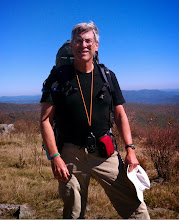Four score and eight years after our forefathers founded a new nation, two great armies fought for about 10 days in this part of Virginia in the Battle of Spotsylvania Court House. It was General Lee vs. General Grant in May, 1864 for the second time that month, and this horrific and bloody battle resulted in 30,000 casualties for the two armies. Left behind as the armies moved ever south towards Richmond were ruined farms and communities
This hike had no such angst or horror for me on a hot August day. My toughest challenge was not anyone shooting at me, but running low on water since I foolishly only brought one liter with me. It always amazes me when I visit a battlefield like this one how such a peaceful and beautiful place could be a scene of such awful things at one time. Although most of the surrounding area has reverted to forest, at the time of the battle the majority of the countryside was farmland and pasture. So the Park Service maintains a lot of the battlefield in open state by mowing. The hike was about 1/3 in woods and 2/3 in open country.
Here are quite a few photos from my hike, a great way to end a busy weekend.
 Map of the trail system and historic features.
Map of the trail system and historic features. The hike started along one of the roads that most people see the park by way of. I only encountered two other hikers in the six miles.
The hike started along one of the roads that most people see the park by way of. I only encountered two other hikers in the six miles.
 Monument to Upton's soldiers, who charged a Confederate position after slealthily approaching along a still existing woods road.
Monument to Upton's soldiers, who charged a Confederate position after slealthily approaching along a still existing woods road. Attractive monument to South Carolina's soldiers at the battle.
Attractive monument to South Carolina's soldiers at the battle. At the "Bloody Angle", men fought at point blank range and hand to hand for 22 hours non-stop. The musket fire was so intense that it cut down a 22 inch thick oak, the stump of which is in the Museum of American History in Washington, DC.
At the "Bloody Angle", men fought at point blank range and hand to hand for 22 hours non-stop. The musket fire was so intense that it cut down a 22 inch thick oak, the stump of which is in the Museum of American History in Washington, DC. Monument to New York or New Jersey at the "Bloody Angle".
Monument to New York or New Jersey at the "Bloody Angle". Union forces led by Hancock charged the "Bloody Angle" from this now pacific terrain.
Union forces led by Hancock charged the "Bloody Angle" from this now pacific terrain. All that remains of the Landram House are two chimney foundations. The house did survive the battle with heavy damage, but the families profitable and productive farm was left in ruins by the fighting. When the family returned, they found 28 Union soldiers buried in their front yard. Another nearby farm had 1,492 Union soldiers buried in its fields, as well as an unknown number of Confederates.
All that remains of the Landram House are two chimney foundations. The house did survive the battle with heavy damage, but the families profitable and productive farm was left in ruins by the fighting. When the family returned, they found 28 Union soldiers buried in their front yard. Another nearby farm had 1,492 Union soldiers buried in its fields, as well as an unknown number of Confederates. A cannon silently guards the approach to the "East Angle".
A cannon silently guards the approach to the "East Angle". The trail runs behind Confederate earthworks at the "East Angle".
The trail runs behind Confederate earthworks at the "East Angle".The hike in open areas often had views of beautiful butterflies and bumblebees. As for larger wildlife, two deer ran 40 feet from me across the trail in one of the wooded areas.







 This pastoral scene was near the Harrison House ruins, location of one of Robert E. Lee's camps.
This pastoral scene was near the Harrison House ruins, location of one of Robert E. Lee's camps. Confederate trenchworks at Lee's Last Line, a nearly impregnable defense designed by military engineer General Martin Smith.
Confederate trenchworks at Lee's Last Line, a nearly impregnable defense designed by military engineer General Martin Smith. The original logs used to fortify trenches have long since rotted away, but this small section has been reconstructed so that people can see what it would have looked like.
The original logs used to fortify trenches have long since rotted away, but this small section has been reconstructed so that people can see what it would have looked like. This monument to beloved Union General "Uncle John" Sedgwick, who was killed by a sniper early in the battle. Note the tree line in the distance - this is where the bullet that killed him came from. His men begged him to take cover, but his last words were "They couldn't hit an elephant from that distance."
This monument to beloved Union General "Uncle John" Sedgwick, who was killed by a sniper early in the battle. Note the tree line in the distance - this is where the bullet that killed him came from. His men begged him to take cover, but his last words were "They couldn't hit an elephant from that distance."








Looks like a great walk and I enjoyed looking at all the photos you took.
ReplyDeleteBeautiful countryside! It is hard to imagine such awful things happening there.
Thank you for your comments and prayers. They mean a lot. :-)